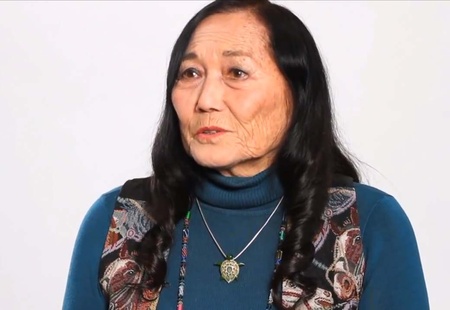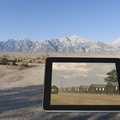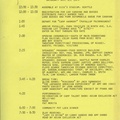2. Unravelling hidden memories < From the late 1960s >
"Farewell to Manzanar" - Jeanne Wakatsuki
"Hey, Auntie, I was born in a place called Manzanar. What was it like there?" my nephew asked me out of nowhere. It was the first time I'd heard about Manzanar from anyone other than my family. As I was telling him about the camp, the terrible sandstorms, the terrible food, the games we played, he asked me, "You were put in prison, but you talk about it as if nothing happened. How do you feel about being incarcerated?" When my nephew asked me how I felt, I allowed myself to feel the emotions I'd been suppressing ever since, and all sorts of feelings welled up inside me, and I burst into tears. 1
At that time, she consulted with her husband, James Houston, who was teaching creative writing at a university, saying, "Jim, I'm thinking of writing a memoir for my family..." and he replied, "What memoir?" She realized then that she hadn't even told her husband about it, even though they had already been married for 14 or 15 years. James encouraged her, saying, "It's not just a story for our family, it's a story that all Americans should read. I'll help you," and "Farewell to Manzanar" was born in 1973.

"People Driven to the Wilderness" by Yoshiko Uchida
I always ask my kids why they think I wrote "Journey to Topaz" and "Coming Home," which are about the wartime experiences of Japanese Americans. "To tell the story of the internment camps," they ask. "Not to tell the story of how I felt, but to tell the story of what happened to Japanese Americans."
"Yes," I reply, but the discussion continues until one of the children says, "You wrote these books so that this never happens again , right?"
Torn Identity - Gene Oishi
The bombs dropped on Pearl Harbor on December 7, 1941 set in motion a series of events that robbed me of my past, my parents, my family, and my childhood. The part of me that was torn away from me was an essential part of who I was. I named the child Hiroshi, and have written about him in my novels and non-fiction, trying to find him somehow, but he always evades me.
I began writing about Hiroshi around 1965 because I felt that the Second World War had split me in two. My American half had survived, my Japanese half had withered away and eventually died. Hiroshi was the last image of my childhood, a union of both. … My hope is to see him in myself. … 3
"The Rabbit in the Moon" by Emi Omori
Why didn't I have children?
Until now, I thought it was because I couldn't maintain a stable relationship with one person or because I didn't have money.
But now that I'm past childbearing age, another answer emerges.
Like me, my birth children are American.
I am an American trapped in the body of an enemy race I don't want.
Could I have hidden from my own child the wish that my child's skin would be a little lighter so that he would not be discriminated against like I was, simply because his face is different ?
This is the beginning of a documentary film directed by Emi Omori. Omori was one year old when she was put in the camp. Many children of that age say they had fun and do not seem to have been affected much by their confinement, but that is not the case for Emi. The death of her mother seems to have played a major role.
Her sister, Chizu, says:
Do you know what happened to my family? My mother died suddenly from a bleeding ulcer at the age of 34, one year after she left the camp. At that time, the doors to all the chapters about the camps were closed for us, and we could not open them for many years. It felt as if my mother's death connected all the terrible things that had happened to us up until then. My mother was gone from us. I made up my mind not to talk about my mother or the camps, and I have done so. My father did not prepare a Buddhist altar for my mother in the house, nor did he hang a photo of her. My mother was gone. She was cremated, and her ashes were placed in a small urn. Our family buried our memories of the camps, along with my mother's urn, in the depths of our consciousness. Fifty years have passed since then, and we no longer know where my mother's urn is. 5
Notes:
1.http://www.calhum.org/experiences/interview-with-jeanne-wakatsuki-houston
2. Yoshiko Uchida, translated by Kazuo Hatano, "People Driven to the Wilderness: Records of a Japanese-American Family During the War," Iwanami Shoten, 1985
3. Gene Oishi, Seiichiro Someya, "Torn Identity: The Life of a Japanese Journalist," Iwanami Shoten, 1989
4. Omori, Emi. (Director/Producer). (1999). Rabbit in the Moon [Documentary Film]. Wabi-Sabi Production.
5. Omori, Emi. (Director/Producer). (1999). Rabbit in the Moon [Documentary Film]. Wabi-Sabi Production.
Although it was understandable that their mother's death was caused by the stress of life in the internment camp, their father's reaction was difficult to understand. However, Professor Kashima pointed out that "something may have happened in the internment camp," and if we think about it that way, it makes a little more sense as to what their father did. Another interesting point is the changes in Japanese community and their father that Emi and Chizu saw after their internment camp experiences. "Although my sister Chizu and I were only 10 years apart, history has separated us as if we were our whole lives. The Japanese community before the war is not the community I know after the war. The community I grew up in was fragmented and prickly, and my father was quiet and unapproachable. My father, who raised my sister before the war, was full of life and dreams and hopes."
*Reprinted from the 137th issue (April 2014) of “Children and Books,” a quarterly magazine published by the Children’s Library Association.
© 2014 Yuri Brockett






